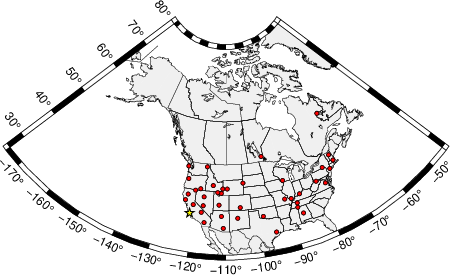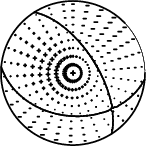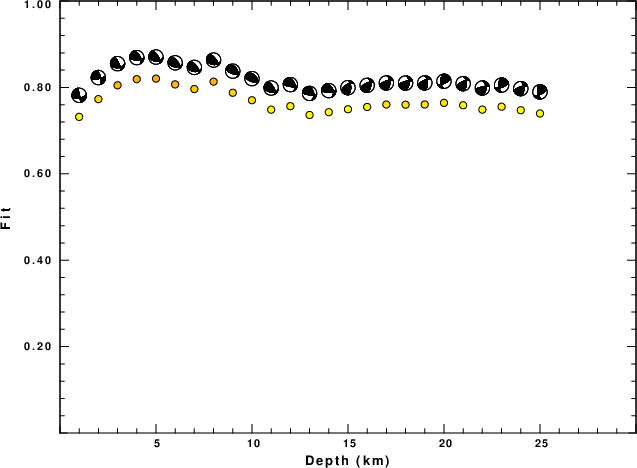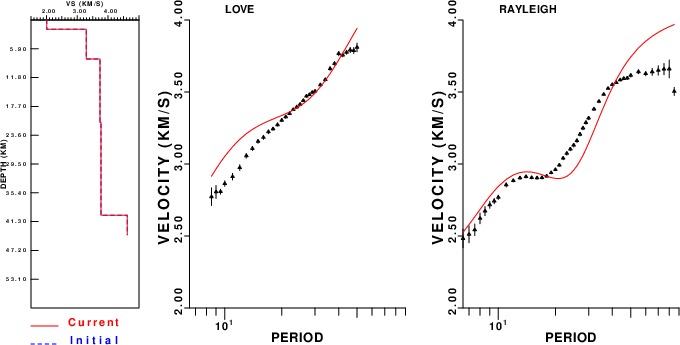
The ANSS event ID is nc21351360 and the event page is at https://earthquake.usgs.gov/earthquakes/eventpage/nc21351360/executive.
2004/03/17 23:53:07 35.731 -121.075 4.3 4.51 California
USGS/SLU Moment Tensor Solution
ENS 2004/03/17 23:53:07:0 35.73 -121.07 4.3 4.5 California
Stations used:
_.CMB _.DAC _.HOPS _.PFO _.TPH
_.WDC AZ.SMER G.SCZ NN.BEK NN.WCN
Filtering commands used:
cut o DIST/3.3 -30 o DIST/3.3 +80
rtr
taper w 0.1
hp c 0.025 n 3
lp c 0.05 n 3
Best Fitting Double Couple
Mo = 5.75e+22 dyne-cm
Mw = 4.44
Z = 5 km
Plane Strike Dip Rake
NP1 95 60 60
NP2 324 41 131
Principal Axes:
Axis Value Plunge Azimuth
T 5.75e+22 62 316
N 0.00e+00 26 111
P -5.75e+22 10 206
Moment Tensor: (dyne-cm)
Component Value
Mxx -3.85e+22
Mxy -2.83e+22
Mxz 2.61e+22
Myy -4.65e+21
Myz -1.22e+22
Mzz 4.32e+22
--------------
----------------------
#############---------------
##################------------
######################------------
#########################-----------
############################----------
############## #############----------
############## T ##############---------
############### ###############---------
-#################################--------
---################################-------
-----##############################------#
--------##########################---###
-------------###################---#####
----------------------------------####
--------------------------------####
-------------------------------###
-----------------------------#
---- --------------------#
- P ------------------
--------------
Global CMT Convention Moment Tensor:
R T P
4.32e+22 2.61e+22 1.22e+22
2.61e+22 -3.85e+22 2.83e+22
1.22e+22 2.83e+22 -4.65e+21
Details of the solution is found at
http://www.eas.slu.edu/eqc/eqc_mt/MECH.NA/20040317235307/index.html
|
STK = 95
DIP = 60
RAKE = 60
MW = 4.44
HS = 5.0
The NDK file is 20040317235307.ndk The waveform inversion is preferred.
The following compares this source inversion to those provided by others. The purpose is to look for major differences and also to note slight differences that might be inherent to the processing procedure. For completeness the USGS/SLU solution is repeated from above.
USGS/SLU Moment Tensor Solution
ENS 2004/03/17 23:53:07:0 35.73 -121.07 4.3 4.5 California
Stations used:
_.CMB _.DAC _.HOPS _.PFO _.TPH
_.WDC AZ.SMER G.SCZ NN.BEK NN.WCN
Filtering commands used:
cut o DIST/3.3 -30 o DIST/3.3 +80
rtr
taper w 0.1
hp c 0.025 n 3
lp c 0.05 n 3
Best Fitting Double Couple
Mo = 5.75e+22 dyne-cm
Mw = 4.44
Z = 5 km
Plane Strike Dip Rake
NP1 95 60 60
NP2 324 41 131
Principal Axes:
Axis Value Plunge Azimuth
T 5.75e+22 62 316
N 0.00e+00 26 111
P -5.75e+22 10 206
Moment Tensor: (dyne-cm)
Component Value
Mxx -3.85e+22
Mxy -2.83e+22
Mxz 2.61e+22
Myy -4.65e+21
Myz -1.22e+22
Mzz 4.32e+22
--------------
----------------------
#############---------------
##################------------
######################------------
#########################-----------
############################----------
############## #############----------
############## T ##############---------
############### ###############---------
-#################################--------
---################################-------
-----##############################------#
--------##########################---###
-------------###################---#####
----------------------------------####
--------------------------------####
-------------------------------###
-----------------------------#
---- --------------------#
- P ------------------
--------------
Global CMT Convention Moment Tensor:
R T P
4.32e+22 2.61e+22 1.22e+22
2.61e+22 -3.85e+22 2.83e+22
1.22e+22 2.83e+22 -4.65e+21
Details of the solution is found at
http://www.eas.slu.edu/eqc/eqc_mt/MECH.NA/20040317235307/index.html
|
This is a preliminary UCB moment tensor solution for the event located
14 km NE of San Simeon, CA; 35.735N 121.075W; Z=2km; ML=4.8; (USGS/UCB
Joint Notification System) on March 17, 2004 at 23:53:07 UTC. Other
information about this event can be viewed at:
http://earthquake.usgs.gov/recenteqsUS/Quakes/nc51139882.htm
Reviewed by:
David Dolenc
UCB Seismological Laboratory
Inversion method: complete waveform
Stations used: CMB, KCC, SAO, and SBC
Berkeley Moment Tensor Solution
Best Fitting Double-Couple:
Mo = 5.50E+22 Dyne-cm
Mw = 4.46
Z = 5 km
Plane Strike Rake Dip
NP1 298 88 49
NP2 121 92 41
Principal Axes:
Axis Value Plunge Azimuth
T 5.503 86 189
N 0.000 2 299
P -5.503 4 29
Event Date/Time: March 17, 2004 at 23:53:07 UTC
Event ID: nc51139882
Moment Tensor: Scale = 10**22 Dyne-cm
Component Value
Mxx -4.125
Mxy -2.338
Mxz -0.735
Myy -1.320
Myz -0.248
Mzz 5.446
-------
------------------
--------------------- P -
----------------------- ---
---------------------------------
---###########---------------------
-####################----------------
--########################-------------
--##########################-----------
----###########################----------
-----############################--------
-----############## #############------
-------############ T ##############-----
--------########### ###############----
---------############################--
-----------##########################--
------------#########################
--------------####################-
-------------------#########-----
-----------------------------
-------------------------
-------------------
-------
|
 |
The focal mechanism was determined using broadband seismic waveforms. The location of the event (star) and the stations used for (red) the waveform inversion are shown in the next figure.

|
|
|
The program wvfgrd96 was used with good traces observed at short distance to determine the focal mechanism, depth and seismic moment. This technique requires a high quality signal and well determined velocity model for the Green's functions. To the extent that these are the quality data, this type of mechanism should be preferred over the radiation pattern technique which requires the separate step of defining the pressure and tension quadrants and the correct strike.
The observed and predicted traces are filtered using the following gsac commands:
cut o DIST/3.3 -30 o DIST/3.3 +80 rtr taper w 0.1 hp c 0.025 n 3 lp c 0.05 n 3The results of this grid search are as follow:
DEPTH STK DIP RAKE MW FIT
WVFGRD96 1.0 235 70 25 4.22 0.4834
WVFGRD96 2.0 85 60 55 4.34 0.5661
WVFGRD96 3.0 90 70 65 4.43 0.6276
WVFGRD96 4.0 90 65 60 4.43 0.6646
WVFGRD96 5.0 95 60 60 4.44 0.6691
WVFGRD96 6.0 85 60 50 4.43 0.6584
WVFGRD96 7.0 75 65 40 4.42 0.6372
WVFGRD96 8.0 90 60 55 4.48 0.6409
WVFGRD96 9.0 80 65 45 4.46 0.6158
WVFGRD96 10.0 80 70 40 4.44 0.5992
WVFGRD96 11.0 250 90 -30 4.43 0.5890
WVFGRD96 12.0 80 65 35 4.46 0.5856
WVFGRD96 13.0 80 65 35 4.46 0.5852
WVFGRD96 14.0 60 70 -25 4.47 0.5804
WVFGRD96 15.0 65 75 -25 4.46 0.5802
WVFGRD96 16.0 65 75 -25 4.47 0.5800
WVFGRD96 17.0 65 75 -25 4.48 0.5794
WVFGRD96 18.0 65 75 -25 4.49 0.5783
WVFGRD96 19.0 65 75 -25 4.49 0.5766
WVFGRD96 20.0 65 75 -25 4.50 0.5742
WVFGRD96 21.0 65 75 -25 4.51 0.5698
WVFGRD96 22.0 65 75 -25 4.52 0.5663
WVFGRD96 23.0 65 75 -25 4.52 0.5619
WVFGRD96 24.0 65 75 -25 4.53 0.5569
WVFGRD96 25.0 65 75 -25 4.53 0.5511
WVFGRD96 26.0 60 70 -25 4.55 0.5455
WVFGRD96 27.0 60 70 -25 4.56 0.5396
WVFGRD96 28.0 65 70 -25 4.56 0.5333
WVFGRD96 29.0 50 55 -15 4.63 0.5282
The best solution is
WVFGRD96 5.0 95 60 60 4.44 0.6691
The mechanism corresponding to the best fit is

|
|
|
The best fit as a function of depth is given in the following figure:

|
|
|
The comparison of the observed and predicted waveforms is given in the next figure. The red traces are the observed and the blue are the predicted. Each observed-predicted component is plotted to the same scale and peak amplitudes are indicated by the numbers to the left of each trace. A pair of numbers is given in black at the right of each predicted traces. The upper number it the time shift required for maximum correlation between the observed and predicted traces. This time shift is required because the synthetics are not computed at exactly the same distance as the observed, the velocity model used in the predictions may not be perfect and the epicentral parameters may be be off. A positive time shift indicates that the prediction is too fast and should be delayed to match the observed trace (shift to the right in this figure). A negative value indicates that the prediction is too slow. The lower number gives the percentage of variance reduction to characterize the individual goodness of fit (100% indicates a perfect fit).
The bandpass filter used in the processing and for the display was
cut o DIST/3.3 -30 o DIST/3.3 +80 rtr taper w 0.1 hp c 0.025 n 3 lp c 0.05 n 3

|
| Figure 3. Waveform comparison for selected depth. Red: observed; Blue - predicted. The time shift with respect to the model prediction is indicated. The percent of fit is also indicated. The time scale is relative to the first trace sample. |

|
| Focal mechanism sensitivity at the preferred depth. The red color indicates a very good fit to the waveforms. Each solution is plotted as a vector at a given value of strike and dip with the angle of the vector representing the rake angle, measured, with respect to the upward vertical (N) in the figure. |
A check on the assumed source location is possible by looking at the time shifts between the observed and predicted traces. The time shifts for waveform matching arise for several reasons:
Time_shift = A + B cos Azimuth + C Sin Azimuth
The time shifts for this inversion lead to the next figure:

The derived shift in origin time and epicentral coordinates are given at the bottom of the figure.
The following figure shows the stations used in the grid search for the best focal mechanism to fit the surface-wave spectral amplitudes of the Love and Rayleigh waves.

|
|
|
The surface-wave determined focal mechanism is shown here.
NODAL PLANES
STK= 327.54
DIP= 62.97
RAKE= 120.68
OR
STK= 95.00
DIP= 40.00
RAKE= 45.00
DEPTH = 5.0 km
Mw = 4.54
Best Fit 0.8204 - P-T axis plot gives solutions with FIT greater than FIT90
 |
Surface wave analysis was performed using codes from Computer Programs in Seismology, specifically the multiple filter analysis program do_mft and the surface-wave radiation pattern search program srfgrd96.
Digital data were collected, instrument response removed and traces converted
to Z, R an T components. Multiple filter analysis was applied to the Z and T traces to obtain the Rayleigh- and Love-wave spectral amplitudes, respectively.
These were input to the search program which examined all depths between 1 and 25 km
and all possible mechanisms.

|
|
|

|
| Pressure-tension axis trends. Since the surface-wave spectra search does not distinguish between P and T axes and since there is a 180 ambiguity in strike, all possible P and T axes are plotted. First motion data and waveforms will be used to select the preferred mechanism. The purpose of this plot is to provide an idea of the possible range of solutions. The P and T-axes for all mechanisms with goodness of fit greater than 0.9 FITMAX (above) are plotted here. |

|
| Focal mechanism sensitivity at the preferred depth. The red color indicates a very good fit to the Love and Rayleigh wave radiation patterns. Each solution is plotted as a vector at a given value of strike and dip with the angle of the vector representing the rake angle, measured, with respect to the upward vertical (N) in the figure. Because of the symmetry of the spectral amplitude rediation patterns, only strikes from 0-180 degrees are sampled. |

|

|
The WUS.model used for the waveform synthetic seismograms and for the surface wave eigenfunctions and dispersion is as follows (The format is in the model96 format of Computer Programs in Seismology).
MODEL.01
Model after 8 iterations
ISOTROPIC
KGS
FLAT EARTH
1-D
CONSTANT VELOCITY
LINE08
LINE09
LINE10
LINE11
H(KM) VP(KM/S) VS(KM/S) RHO(GM/CC) QP QS ETAP ETAS FREFP FREFS
1.9000 3.4065 2.0089 2.2150 0.302E-02 0.679E-02 0.00 0.00 1.00 1.00
6.1000 5.5445 3.2953 2.6089 0.349E-02 0.784E-02 0.00 0.00 1.00 1.00
13.0000 6.2708 3.7396 2.7812 0.212E-02 0.476E-02 0.00 0.00 1.00 1.00
19.0000 6.4075 3.7680 2.8223 0.111E-02 0.249E-02 0.00 0.00 1.00 1.00
0.0000 7.9000 4.6200 3.2760 0.164E-10 0.370E-10 0.00 0.00 1.00 1.00